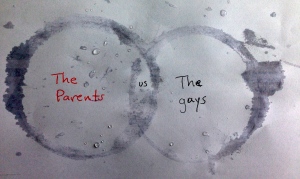Here’s a question I’ve been putting off because we don’t really have a good answer for it:
“How will the legalities be handled with E having the baby and H being E’s spouse? (but not recognized as such everywhere) How does adoption work in such circumstances?”
Let’s start with this map, courtesy of wikipedia:
Just before moving to Singapore, E and I lived in Michigan. We’re registered to vote in Michigan and have drivers licenses for Michigan. (For our non-American readers, Michigan is the one that looks like a mitten or, on this map, the red one in the north.) In theory, we could change our state since we don’t really live there anyway, but that’s complicated and usually involves demonstrating that we’ve set up a residence in our new state. Hard to do when, again, we don’t really live there. Realistically, we’re probably stuck with Michigan as our state until we move back to the US and take up residence elsewhere. (This isn’t strictly relevant to today’s topic, but for future reference, we were legally married in Illinois. Michigan does not recognize our marriage.)
So what does this map mean for us?
Assuming the situation is static (but hoping it’s not – c’mon SCOTUS!), it’s actually not clear what would happen in our situation. Michigan does not permit same-sex couples to adopt a child together, but there is no explicit prohibition on one partner adopting a child born to the other partner. Wikipedia calls this “stepparent adoption,” but it’s more commonly known as “second parent adoption,” even though these are technically different: stepparent adoption is for married couples, while second parent adoption is for a couple that isn’t married. But because some states are a little stingy with the marriage rights, a lot of co-parenting couples aren’t legally married, so second parent adoption is the more general term for everyone in that situation. (“Stepparent” also seems kind of misleading to me. I’m not adopting a child that E had as part of a previous relationship. I’m going to be there right from the start, as much a co-parent as E.)
Anyway, at present, Nessel & Kessel Law (no joke, that’s their name), the same firm that was part of Michigan’s DeBoer v. Snyder case back in March, is looking for same-sex Michigan couples who are legally married somewhere to file petitions for second parent adoptions to get the ball rolling on this issue.
As expats living in Asia, we’re obviously not ideal candidates, so we’re basically just waiting to see what happens, either with a Supreme Court ruling or a Michigan ruling. We’re confident that I’ll eventually be able to adopt our child, but it may be a little while.
In the meantime, we’re going to have some legal documents drawn up including a co-parenting agreement and a custody agreement. That way, everyone’s protected even if something bad happened to E or to our relationship. It’s not very romantic, and it’s definitely less joyful than signing my name to the birth certificate, but for the moment, it’s the closest we can have to an adoption.
I will leave you with the advice E was given last year by her former ob-gyn in Ann Arbor, MI: “Make sure you don’t put your girlfriend’s name on any legal paperwork. That way, if you break up, she won’t have any claim to your child.” Classy.
Send us more questions through our anonymous question box.
-H


